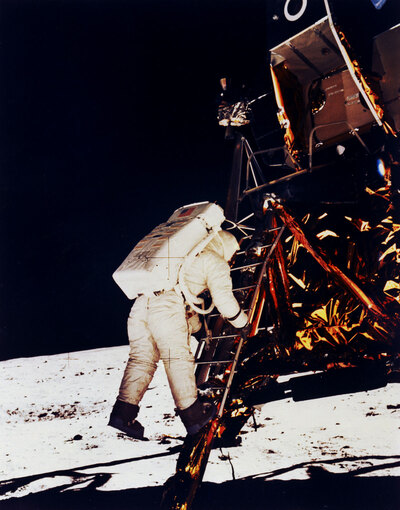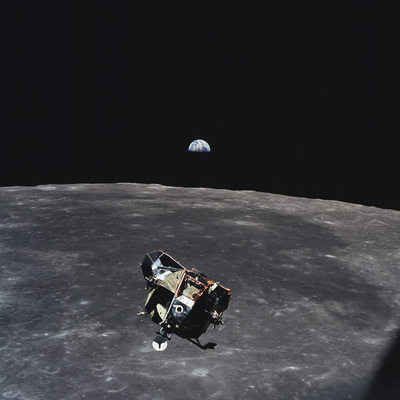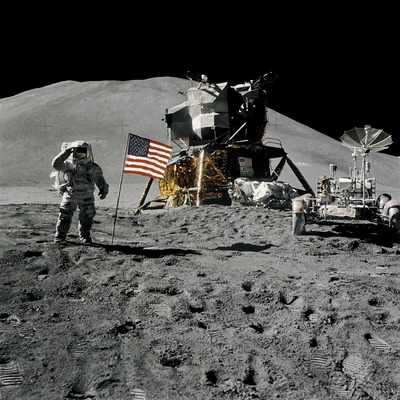To the moon
This year, July 20, 2019 marks the fiftieth anniversary of the first moon landing.

It’s hard to believe it was fifty years ago. Maybe half the people on earth today weren’t alive when we did it. Maybe more. I was a little kid, and remember watching on a little black and white television as Neil Armstrong stepped off of the ladder.
The photo is a picture that Neil Armstrong made of Buzz Aldrin following him a little while later. It’s a photo of the second man setting foot on the moon. These days we would say, “second person,” but I like “second man” because they were all men and one day there might be a second woman.
When I was a kid we thought we’d make a permanent human presense on the moon, moon colonies. I thought it was the first excursion into space and that we were really going, that it was just the beginning. We did get a more or less permanent presence in orbit with SkyLab and now the International Space Station, but never went back to the moon.
Instead, we got the internet.
To relive the days when human beings went to the moon, there’s lots of cool media:
- Apollo 11 (2019), this year’s documentary about the first moon landing.
- First Man (2018), a drama based on the life of Neil Armstrong
- For All Mankind (1989), a documentary using only NASA footage and voices of the people involved in the missions, incuding astronauts and flight controllers.
- Apollo 13 (1995), the most famous hollywood effort, with Tom Hanks as James Lovell
- 13 minutes to the moon, a BBC podcast currently rolling-out to celebrate the anniversary
- Apollo and The Moon, a NASA Johnson Space Center podcast episode

Of the movies, my favorite is “For All Mankind”, despite the title, because it has lots of video and audio of the people involved. Of all, it gives the greatest feel for the times. It has great music from Brian Eno, and footage of the astronauts playing, just messing around on a moon walk.
The podcast from BBC is a lot of fun. It’s always slow to get started, but once it gets going it presents many details I’ve never heard about. For one thing, it has interviews and descriptions about mission control, the software, and the engineering processes around the effort.
NASA Science currently has a lovely page about the moon with landing sites marked, information about the Lunar Reconnaissance Orbiter, a list of the twenty-four men who travelled there and the twelve who walked on its surface, photos, and close-up videos of the lunar surface. There’s also the Apollo missions page which is a portal to official, authentic, historical photos, video, and audio.
The articles about the Apollo program on Wikipedia are extensive and detailed.
Watching the movies, back in the sixties, they said “Man” and “Mankind” when they talked about humans. There were some women involved in the effort, notably Margaret Hamilton at MIT, who wrote a lot of the software that landed us. These days you see things more correctly worded like, “Twenty-four human beings have travelled from the Earth to Moon” although in fact they were all men. The vast majority of the people directly involved were men. It’s striking now how dominant men were in the culture of science and engineering. It’s striking to hear how embedded that was in the language, how we talked about the people involved. It was always “men.”
The plaque left at tranquility base, on a leg of the landing stage behind the ladder says, “Here men first set foot on the moon … We came in peace for all mankind.” No-one gave that a second thought.

Some movies I haven’t seen and might try to watch:
- To the Moon, an episode of Nova that aired in 1999, near the 30th anniversary
- When we left the earth, seven TV miniseries episodes from 2008
- Moon Shot (1994), a three hour TV movie aired around the time of the 25th anniversary
And just like the United States, wouldn’t you know? We had to send cars to the moon. In truth, they were quite useful, enabling exploration as far as about five miles from the lander. We left three moon buggies there, delivered on the last three missions. The last time humans were on the moon was early morning December 14, 1972.